(Written by William)
In this Brick Breakdown series I review official LEGO sets, from the perspective of looking at interesting building techniques we can all learn from. Today we will be looking at the #70404 LEGO Castle King’s Castle set. You can also check out the previously discussed LEGO techniques found in official LEGO sets at the end of this article. 🙂
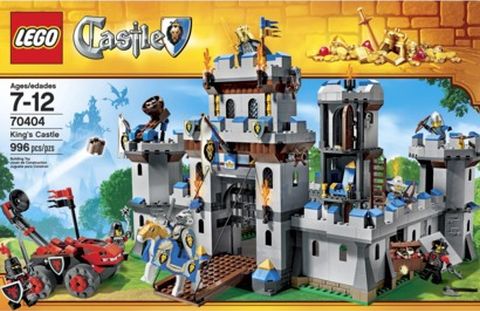
We haven’t talked about LEGO Castle sets for a while now as they have been overshadowed by other exciting LEGO themes. However the fact remains that LEGO Castle is one of the oldest LEGO themes (along with LEGO City and LEGO Space). The current LEGO Castle theme is simply called LEGO Castle, including five sets; the largest one amongst them being the #70404 LEGO King’s Castle. Through the years LEGO released many sets called the King’s Castle – some better than others.

This version of the classic LEGO Castle is definitely not the fanciest nor is it the most innovative. It is a straightforward and basic design – something LEGO Castle fans could start with and build up on. This set is actually a good reminder that in order to come up with complex designs, it is a good idea to start from a simpler version then build from there. The recommended age-range for this set is 7-12, which means that it can’t get much easier to build a full castle and still have something for older fans to enjoy. With that said, we’re going to look at some of the techniques utilized in this set, and even if LEGO Castle is not your thing, we will look at techniques that can be applied to a wide range of designs.
➡ BUILDING MASS WITH LEGO
Sometimes when building with LEGO size is the goal. After all no one cowers under the shadow of a small castle. However, given the fact that we can’t make everything to scale, there will be times we just need to give the illusion of size. This is where we need to build mass to our LEGO model. This is represented in the LEGO King’s Castle to the left and right of the front gate, the back corners, and the back tower. They are primarily wall sections with small windows to look like there are interior rooms inside, however there is actually no access to these spaces.
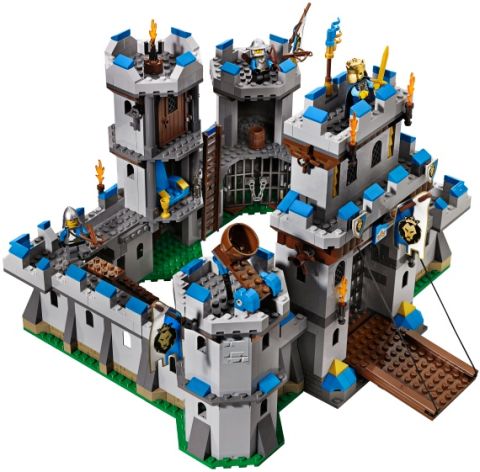
If you need space filled up in your LEGO creation, you’re going to need to think of a couple of things. First of all, make sure the space is hollow – you could build solid, but this will take more pieces, and make the model really heavy. A lighter LEGO model is more efficient in piece usage and will make handling easier. The other feature you want to consider is that if you have windows make sure they are darkened to conceal the fact that you are not using the interior space. Also, building mass will reinforce your interlocking bricks technique. You don’t want to use a whole bunch of straight columns of bricks – the idea is that you are making one large cohesive piece that can fill up space. The result will be a LEGO model that looks large and bulky in areas you want, with relatively little effort.
➡ USING LEGO STRING-REELS
Ever since the first LEGO Castle, LEGO designers have been using strings to raise and lower the drawbridges and portcullises. Ultimately there are two approaches to using a string-reel, and this set uses both of them. The first use is the tension-reel. This reel has a stiff action, so that no matter how the reel is wound, it will stay in place. The LEGO King’s Castle uses this type of reel at the drawbridge. The bushes are used to create a tight hold by pushing up against the LEGO Technic bricks – thereby giving friction. The end result is that you get slow movement no matter which way you turn the reel.
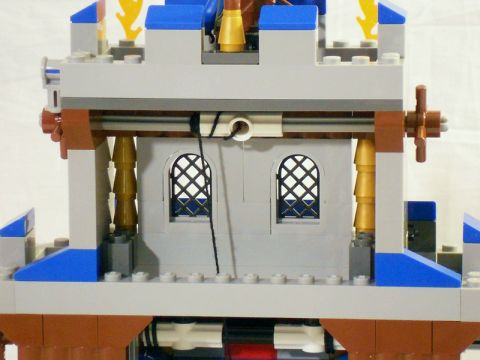
The other method of using a string-reel is to create a catch. This is used for the portcullis’s reel. The axle remains loose and if you want to stop the reel, you simply move the LEGO Technic piece in place to stop the handle from turning. This is ideal if you are using gravity and need a quick release action.
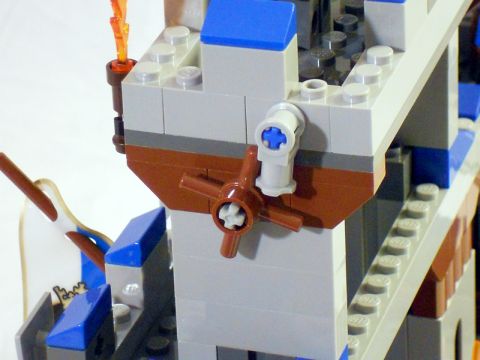
➡ CREATING A LEGO SPRING
One of the most interesting designs of the LEGO King’s Castle is the catapult on one of its towers. I should admit that I am not a big fan of catapults simply because I feel they are overused, however this one impressed me because of the technique used by LEGO designers. First of all they created a spring. For this they needed a piece with two qualities; flexibility and resiliency. Often rubber-bands are best for this, but in this case a rubber axle-hose was used. I should probably explain here what I mean by “flexible” and “resilient.” Flexible is simple; all it means is a piece that can bend and not break. Resilient is the quality that means a piece will go back to its original shape. So for instance, a string is flexible but not resilient.
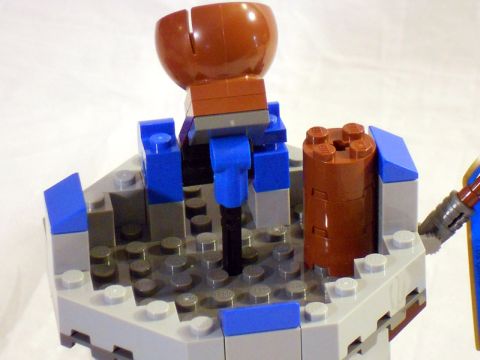
In order to do this, LEGO designers did something special with the hose they used here. Normally a hose is not entirely resilient as it starts taking the shape of whichever way you bend it. However, if you restrain the majority of the hose and only expose a small section, you will increase the resiliency of the exposed section. Note how the majority of the hose is located on the second floor of the tower and only a little bit is up top.
Next, LEGO designers used the catapult itself to define the limits of the spring. When building the catapult you will use a black pin and a gray pin to connect it. The black pin is a friction pin (you may notice the lines that run the length of the pin). This restricts the turning movement. The gray pin, on the other hand, can spin free. What is happening here is that the pins adjust how much force is used to move the catapult; put two gray pins and the bowl section will flip over and hang off the side of the tower. Put two black pins and the hose may not have enough force to move the catapult. So what you end up with is a spring that has just the right amount of force to launch a projectile, but not enough to move it any further than what it can reach. And this should be your goal when you make a LEGO spring, after all you do want to like the way something looks when the flexible piece has returned to its normal shape.
➡ APPLYING WHAT YOU LEARN
Building mass to a LEGO creation equates to a larger size. It is often the case that this additional bulk helps put things in context. Guns on a spaceship for instance look much more impressive with size. Just make sure that the size you add still connects solidly with the rest of your model. String-reels are an easy and fun way to create a nice moving feature. The question is what type of reel best fits your needs; you can go slow and steady with friction or fast with a catch. Finally, creating your own LEGO spring is not a technique often used as the majority of LEGO elements are too rigid to even meet the requirements needed. In fact, spring mechanisms are fairly rare in LEGO creations, so there is plenty of room for LEGO builders to be the first to find new applications with this technique.
So what do you think? How do you like the LEGO King’s Castle set and the techniques we discussed here? Do you prefer to build realistic LEGO creations or prefer to make adjustments for playability? And how about open floor-plans? Do you use them in your own LEGO buildings? Feel free to share your own experiences, tips or ask questions in the comment section below! 😉

And you might also like to check out the other reviews in this series:
- Brick Breakdown: LEGO Cinderella’s Castle
- Brick Breakdown: LEGO MetalBeard’s Sea Cow
- Brick Breakdown: LEGO MetalBeard’s Duel
- Brick Breakdown: LEGO Minecraft Sets
- Brick Breakdown: LEGO Disney Princess Sets
- Brick Breakdown: LEGO Back to the Future DeLorean
- Brick Breakdown: The LEGO Movie Ice Cream Truck
- Brick Breakdown: LEGO Parisian Restaurant
- Brick Breakdown: The LEGO Movie Flying Flusher
- Brick Breakdown: LEGO The Hobbit Dol Guldur Battle
- Brick Breakdown: LEGO Winter Village Cottage
- Brick Breakdown: LEGO Winter Village Market
- Brick Breakdown: LEGO Lord of the Rings Council of Elrond
- Brick Breakdown: LEGO Castle Dragon Mountain
- Brick Breakdown: LEGO Lord of the Rings Pirate Ship Ambush
- Brick Breakdown: LEGO Ninjago Golden Dragon
- Brick Breakdown: LEGO Superman Black Zero Escape
- Brick Breakdown: LEGO Tower of Orthanc
- Brick Breakdown: LEGO City Dump Truck
- Brick Breakdown: LEGO Monster Fighters Ghost Train
- Brick Breakdown: LEGO Lone Ranger Silver Mine Shootout
- Brick Breakdown: LEGO Lone Ranger Constitution Train Chase
- Brick Breakdown: Ninjago Temple of Light
- Brick Breakdown: LEGO Lone Ranger Colby City Showdown
- Brick Breakdown: LEGO Lone Ranger Comanche Camp
- Brick Breakdown: LEGO Lone Ranger Stagecoach
- Brick Breakdown: LEGO Star Wars AT-RT
- Brick Breakdown: LEGO Arkham Asylum Part 1
- Brick Breakdown: LEGO Arkham Asylum Part 2
- Brick Breakdown: Legends of Chima Polybags












I don’t have any Castle sets, or LotR, so this would be a good castle for me to get (Although I’d really prefer Helm’s Deep). 🙂 But this comes with a drawbridge!
So, do you just pull down the catapult and release it to make it shoot? The axle’s resilience just pushes it back? 😕
And for anyone who doesn’t yet know, the Exo-suit has been revealed: http://brickset.com/article/11658/the-exo-suit-has-been-revealed! 😀 😛
Helms deep is a vastly better castle but now not that cheap. If you can get multiples of them you get an incredible set of really useful bricks for castle/stonework if city is your thing 🙂
Well, I found one on Bricklink for only $145, so I’ll save up for that, but I won’t get multiple. The Uruk-hai Army is the set to get two of.
Dang, I was just about to post that same thing… http://www.brothers-brick.com/2014/07/04/lego-ideas-exo-suit-officially-revealed-news/
I’ve been eyeballing this castle. l like it even if it is simplistic. I like that it comes with a King minifigure because the older castles that I have, Black Monarch’s and Black Falcon’s did not. My only complaint is that you don’t get as many minifigures to really bulk up an army or a defense of the castle as you did back in the days of the older sets.
OMG!!! You have the Black Falcons???
I do. Not the original release, I have the re-release that was released in the early 2000s but it was identical I believe. My brother has the King’s Castle from the 80s with the Lion Knights that was the “opposing” good guys castle to the Black Falcons.
I’m so jelly (as Batman would say)… love the Black Falcons! I have an army of the Lion Knights, but no Falcons. There were some rumors of the Falcons coming back when the Kingdoms Joust set was released a couple of years ago, as the black knight has the Falcon logo, but then nothing happened. 😕
What are the Black Falcons?
They are one of thhe LEGO Castle series from the 1980s. They have blue and black uniforms with a silver/black falcon: https://www.bricklink.com/catalogList.asp?catType=S&catString=9.289
A lot of people really like them, even those born later. They just really look good in big armies! Search Black Falcons on Google images. 😉
I must say I did not really think this set was cool but this shows some great features, nice post admin!
This article was written by William, so thank him. 😉
The set LEGO 71040 with light really fascinated me by its shimmer when I turned off all the lights in its room with the other Creator sets.